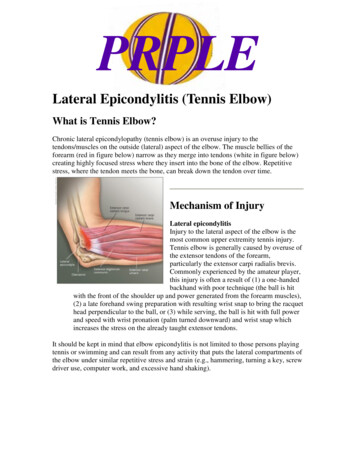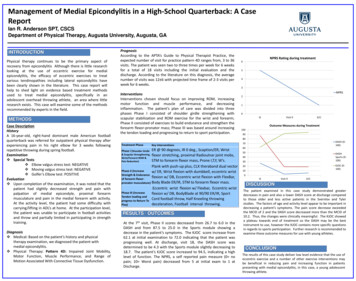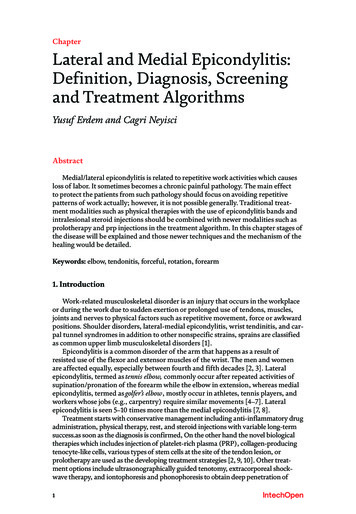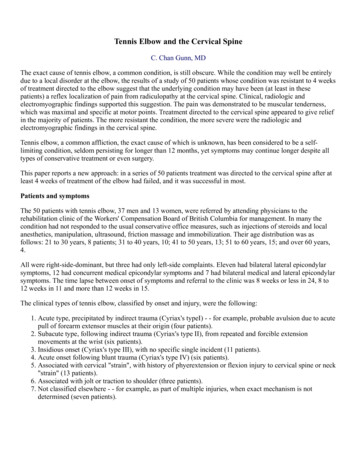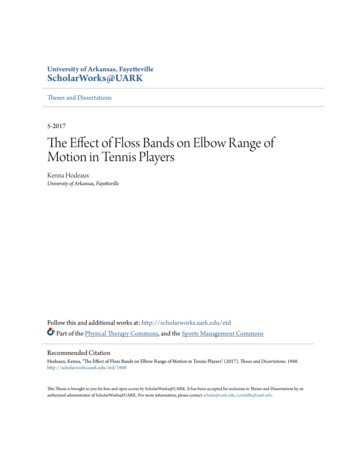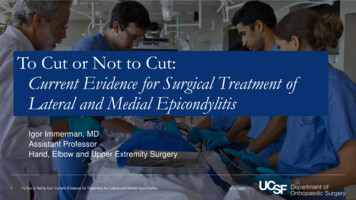Transcription
.orgTennis Elbow (Lateral Epicondylitis)Page ( 1 )Tennis elbow, or lateral epicondylitis, is a painful condition of the elbow causedby overuse. Not surprisingly, playing tennis or other racquet sports can cause thiscondition. However, several other sports and activities can also put you at risk.Tennis elbow is an inflammation of the tendons that join the forearm muscles onthe outside of the elbow. The forearm muscles and tendons become damagedfrom overuse — repeating the same motions again and again. This leads to pain andtenderness on the outside of the elbow.There are many treatment options for tennis elbow. In most cases, treatmentinvolves a team approach. Primary doctors, physical therapists, and, in some cases,surgeons work together to provide the most effective care.AnatomyThe ECRB muscle and tendon isusually involved in tennis elbow.Your elbow joint is a joint made up of three bones: your upper arm bone (humerus)and the two bones in your forearm (radius and ulna). There are bony bumps at thebottom of the humerus called epicondyles. The bony bump on the outside (lateralside) of the elbow is called the lateral epicondyle.Reproduced and modified from TheBody Almanac. American Academyof Orthopaedic Surgeons, 2003.Muscles, ligaments, and tendons hold the elbow joint together.Lateral epicondylitis, or tennis elbow, involves the muscles and tendons of yourforearm. Your forearm muscles extend your wrist and fingers. Your forearm tendons— often called extensors — attach the muscles to bone. They attach on the lateralepicondyle. The tendon usually involved in tennis elbow is called the ExtensorCarpi Radialis Brevis (ECRB).CauseOveruseRecent studies show that tennis elbow is often due to damage to a specific forearmmuscle. The extensor carpi radialis brevis (ECRB) muscle helps stabilize the wristwhen the elbow is straight. This occurs during a tennis groundstroke, for example.When the ECRB is weakened from overuse, microscopic tears form in the tendonwhere it attaches to the lateral epicondyle. This leads to inflammation and pain.The ECRB may also be at increased risk for damage because of its position. As theelbow bends and straightens, the muscle rubs against bony bumps. This can causegradual wear and tear of the muscle over time.AAOS does not endorse any treatments, procedures, products, or physicians referenced herein. This information is provided as an educational service and is notintended to serve as medical advice. Anyone seeking specific orthopaedic advice or assistance should consult his or her orthopaedic surgeon, or locate one in yourarea through the AAOS “Find an Orthopaedist” program on OrthoInfo.org.Copyright 1995-2015 by the American Academy of Orthopaedic Surgeons.
.orgTennis Elbow (Lateral Epicondylitis) cont.Page ( 2 )ActivitiesAthletes are not the only people who get tennis elbow. Many people with tenniselbow participate in work or recreational activities that require repetitive andvigorous use of the forearm muscle.Painters, plumbers, and carpenters are particularly prone to developing tenniselbow. Studies have shown that auto workers, cooks, and even butchers get tenniselbow more often than the rest of the population. It is thought that the repetitionand weight lifting required in these occupations leads to injury.AgeMost people who get tennis elbow are between the ages of 30 and 50, althoughanyone can get tennis elbow if they have the risk factors. In racquet sports liketennis, improper stroke technique and improper equipment may be risk factors.UnknownLateral epicondylitis can occur without any recognized repetitive injury. Thisoccurence is called “insidious” or of an unknown cause.Courtesy Thinkstock 2015.SymptomsThe symptoms of tennis elbow develop gradually. In most cases, the pain begins asmild and slowly worsens over weeks and months. There is usually no specific injuryassociated with the start of symptoms.Common signs and symptoms of tennis elbow include: Pain or burning on the outer part of your elbow Weak grip strengthThe symptoms are often worsened with forearm activity, such as holding a racquet,turning a wrench, or shaking hands. Your dominant arm is most often affected;however both arms can be affected.Location of pain in lateralepicondylitis.Reproduced from Griffen L (ed):Essentials of Musculoskeletal Care,Third Edition. American Academyof Orthopaedic Surgeons, 2005.AAOS does not endorse any treatments, procedures, products, or physicians referenced herein. This information is provided as an educational service and is notintended to serve as medical advice. Anyone seeking specific orthopaedic advice or assistance should consult his or her orthopaedic surgeon, or locate one in yourarea through the AAOS “Find an Orthopaedist” program on OrthoInfo.org.Copyright 1995-2015 by the American Academy of Orthopaedic Surgeons.
.orgTennis Elbow (Lateral Epicondylitis) cont.Page ( 3 )Doctor ExaminationYour doctor will consider many factors in making a diagnosis. These include howyour symptoms developed, any occupational risk factors, and recreational sportsparticipation.Your doctor will talk to you about what activities cause symptoms and where onyour arm the symptoms occur. Be sure to tell your doctor if you have ever injuredyour elbow. If you have a history of rheumatoid arthritis or nerve disease, tell yourdoctor.During the examination, your doctor will use a variety of tests to pinpoint thediagnosis. For example, your doctor may ask you to try to straighten your wrist andfingers against resistance with your arm fully straight to see if this causes pain. Ifthe tests are positive, it tells your doctor that those muscles may not be healthy.Tests X-rays. These tests provide clear images of dense structures like bone. Theymay be taken to rule out arthritis of the elbow. Magnetic resonance imaging (MRI) scan. If your doctor thinks your symptomsare related to a neck problem, an MRI scan may be ordered. MRIs scans showdetails of soft tissues, and will help your doctor see if you have a possibleherniated disk or arthritis in your neck. Both of these conditions often producearm pain. Electromyography (EMG). Your doctor may order an EMG to rule out nervecompression. Many nerves travel around the elbow, and the symptoms of nervecompression are similar to those of tennis elbow.Wrist stretching exercise with elbowextended.TreatmentNonsurgical TreatmentApproximately 80% to 95% of patients have success with nonsurgical treatment.Rest. The first step toward recovery is to give your arm proper rest. This meansthat you will have to stop participation in sports or heavy work activities for severalweeks.Non-steroidal anti-inflammatory medicines. Drugs like aspirin or ibuprofen reducepain and swelling.AAOS does not endorse any treatments, procedures, products, or physicians referenced herein. This information is provided as an educational service and is notintended to serve as medical advice. Anyone seeking specific orthopaedic advice or assistance should consult his or her orthopaedic surgeon, or locate one in yourarea through the AAOS “Find an Orthopaedist” program on OrthoInfo.org.Copyright 1995-2015 by the American Academy of Orthopaedic Surgeons.
.orgTennis Elbow (Lateral Epicondylitis) cont.Page ( 4 )Equipment check. If you participate in a racquet sport, your doctor may encourageyou to have your equipment checked for proper fit. Stiffer racquets and looserstrung racquets often can reduce the stress on the forearm, which means thatthe forearm muscles do not have to work as hard. If you use an oversized racquet,changing to a smaller head may help prevent symptoms from recurring.Physical therapy. Specific exercises are helpful for strengthening the muscles ofthe forearm. Your therapist may also perform ultrasound, ice massage, or musclestimulating techniques to improve muscle healing.Counterforce brace.Brace. Using a brace centered over the back of your forearm may also help relievesymptoms of tennis elbow. This can reduce symptoms by resting the muscles andtendons.Steroid injections. Steroids, such as cortisone, are very effective anti-inflammatorymedicines. Your doctor may decide to inject your damaged muscle with a steroid torelieve your symptoms.Extracorporeal shock wave therapy. Shock wave therapy sends sound wavesto the elbow. These sound waves create “microtrauma” that promote the body’snatural healing processes. Shock wave therapy is considered experimental by manydoctors, but some sources show it can be effective.Surgical TreatmentIf your symptoms do not respond after 6 to 12 months of nonsurgical treatments,your doctor may recommend surgery.Most surgical procedures for tennis elbow involve removing diseased muscle andreattaching healthy muscle back to bone.The right surgical approach for you will depend on a range of factors. Theseinclude the scope of your injury, your general health, and your personal needs. Talkwith your doctor about the options. Discuss the results your doctor has had, andany risks associated with each procedure.Open surgery. The most common approach to tennis elbow repair is open surgery.This involves making an incision over the elbow.Open surgery is usually performed as an outpatient surgery. It rarely requires anovernight stay at the hospital.AAOS does not endorse any treatments, procedures, products, or physicians referenced herein. This information is provided as an educational service and is notintended to serve as medical advice. Anyone seeking specific orthopaedic advice or assistance should consult his or her orthopaedic surgeon, or locate one in yourarea through the AAOS “Find an Orthopaedist” program on OrthoInfo.org.Copyright 1995-2015 by the American Academy of Orthopaedic Surgeons.
.orgTennis Elbow (Lateral Epicondylitis) cont.Page ( 5 )Arthroscopic surgery. Tennis elbow can also be repaired using miniatureinstruments and small incisions. Like open surgery, this is a same-day or outpatientprocedure.Surgical risks. As with any surgery, there are risks with tennis elbow surgery. Themost common things to consider include: Infection Nerve and blood vessel damage Possible prolonged rehabilitation Loss of strength Loss of flexibility The need for further surgeryRehabilitation. Following surgery, your arm may be immobilized temporarily with asplint. About 1 week later, the sutures and splint are removed.After the splint is removed, exercises are started to stretch the elbow and restoreflexibility. Light, gradual strengthening exercises are started about 2 months aftersurgery.Your doctor will tell you when you can return to athletic activity. This is usually 4 to 6months after surgery. Tennis elbow surgery is considered successful in 80% to 90%of patients. However, it is not uncommon to see a loss of strength.New DevelopmentsPlatelet-rich plasma (PRP) is currently being investigated for its effectiveness inspeeding the healing of a variety of tendon injuries. PRP is a preparation developedfrom a patient’s own blood. It contains a high concentration of proteins calledgrowth factors that are very important in the healing of injuries.Current research on PRP and lateral epicondylitis is very promising. A fewtreatment centers across the country are incorporating PRP injections into thenonsurgical treatment regimen for lateral epicondylitis. However, this methodis still under investigation and more research is necessary to fully prove PRP’seffectiveness.OrthoInfo.org provides expert information about a wide range of musculoskeletalconditions and injuries. All articles are developed by orthopaedic surgeons who aremembers of the American Academy of Orthopaedic Surgeons (AAOS). To learn moreabout your orthopaedic health, please visit orthoinfo.org.An injection of PRP is used to treattennis elbow.Courtesy of Allan K. Mishra, MD,Menlo Park, CA.AAOS does not endorse any treatments, procedures, products, or physicians referenced herein. This information is provided as an educational service and is notintended to serve as medical advice. Anyone seeking specific orthopaedic advice or assistance should consult his or her orthopaedic surgeon, or locate one in yourarea through the AAOS “Find an Orthopaedist” program on OrthoInfo.org.Copyright 1995-2015 by the American Academy of Orthopaedic Surgeons.
elbow. Studies have shown that auto workers, cooks, and even butchers get tennis elbow more often than the rest of the population. It is thought that the repetition and weight lifting required in these occupations leads to injury. Age Most people who get tennis elbow are between the ages of 30 and 50, although anyone can get tennis elbow if .
